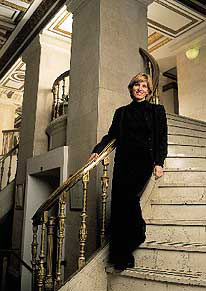
Photograph by André Souroujon at the Times
In 1991, when Times Square seemed a permanent crime scene, Rosanne Haggerty envisioned a system that could save the neighborhood, its historic buildings, and—most importantly—its homeless people. As founder of Common Ground Community, she devised a service to aid the homeless by providing safe and affordable housing along with social support. The recipient of a 2001 MacArthur Fellowship, Haggerty says her goal is to complete her M.A. in Planning and Historic Preservation this year. It’s been hard to find the time to finish her thesis—she’s been busy overseeing the transformation of several decrepit hotels into residences to house more than 1,500 tenants, who she is also helping to ease back into the workforce.
Why is making renovations of old buildings and hotels the approach you’ve taken to create housing?
The original layouts of these buildings, many of which were once hotels, lend themselves well to SRO (single-room occupancy) facilities. The buildings contain common spaces that are important for community building. I’m personally interested in historic architecture of various types, so it’s been a real treat to focus development energy for the homeless on buildings that can contribute so much to the neighborhood once they’re restored. It’s been a psychologically powerful tool to take down rundown hulks and restore and reclaim them as landmarks.
Why aren’t more groups making more housing developments?
It really comes down to political will and money and making the process easier. Money continues to go out to emergency-based approaches that cost a lot more than the permanent solutions we have been implementing. The good news is that we ultimately piece money together from public and private sources. The time it takes and the degree of difficulty is completely disproportionate to the staff resources a not-for-profit group has.
What role can architects play?
An exciting challenge for the architectural community would be finding more affordable ways to build attractive housing and widening the spectrum of housing types available so we can get more people indoors and living in safety and with dignity in a place where they can move on with their lives—perhaps borrowing from other traditions.
Other traditions?
For example, we are working on a new project that is currently used in Belfast and London. We’re renovating a building for The Foyer Project. It provides a residential/job development center aimed at those coming out of foster care—a demographic that we find all too often pours more people into the homeless problem.
What can be done in other communities to launch SRO projects?
My fantasy is that architects wouldn’t wait for commissions or calls from groups but would actively engage the issue and the necessary groups. For instance, in England, a group called CRASH (Construction Industry for Single Homelessness) is comprised of socially minded architects and builders who rally expertise and contribute materials and labor for a project—they make the difference in a project happening or not.
How do you measure success?
There are the tangible metrics—turnover, a tenant’s progress onto something better, rent collection, decreased hospitalizations, and decreased need of emergency services. But there are other things that we are not able to quantify, such as the participation and spirit in group events. The ultimate barometer, however, is how people feel about the atmosphere when they walk into it. My coworkers and I, and the tenants, are rarely disappointed.

Post a comment to this article
Report Abusive Comment